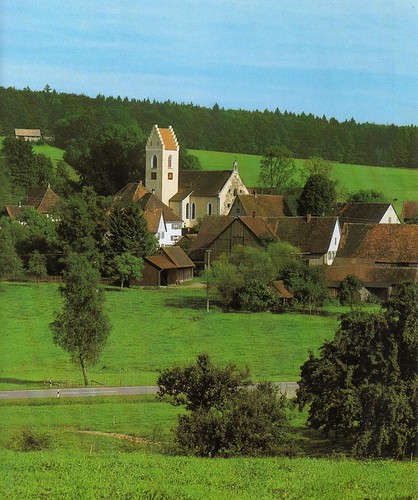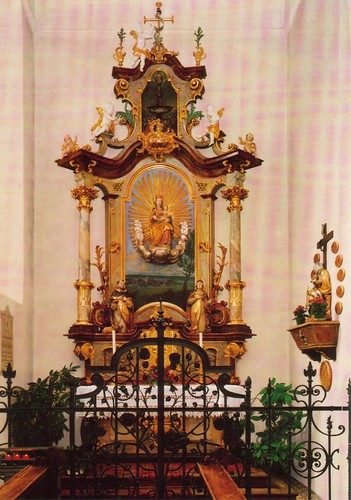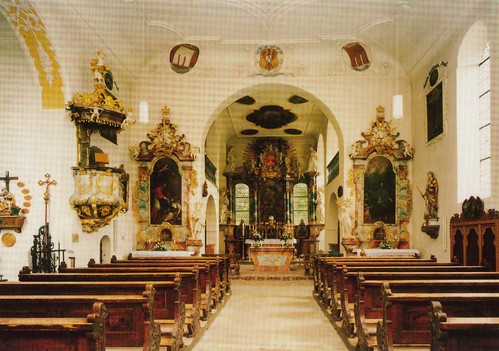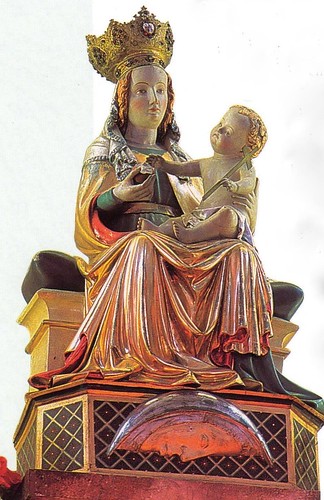
The main focus of the church and Mediatrix of Grace emphasized that glitters since 1790, the Blessed Mother statue, like a pearl in its shell, in the classical design of the high altar center. The image of one of the "Beautiful Madonna" Mother of the corresponding Birnau applies to admirers and experts as "the most beautiful end enthroned Madonna in Upper Swabia. He was also the great paintings on the ceiling above the nave of the sanctuary is dedicated. Angel bear there the picture of grace in the church to honor the new shrine with it and continue the tradition of Marian devotion Altbirnauer. The
about one meter high sculpture of the Madonna with the soft flowing Case of the robe and the deep creases between the feet, a bowl of Gothic architecture around 1430 According to research by Jürgen Michler it can be compared with works of sculpture of the city of Ulm retired during the years 1420/36. be especially crafted decorative stone sculptures of the Ulm Cathedral facade and related work on the Überlingen Münster, both in the decorative style and in the delicate line of beauty, the stylistic relationships between the Birnau picture of grace and the Ulm school, see particularly the "Masters of the mandrel townspeople altar". Especially as a written source in 1430 a "Maister of Ulm" testified for work in Überlingen, is the stylistic classification to be derived in the art-historical context is not difficult. Has remained unclear why in 1430 a new image of the enthroned Virgin for old Birnau was carved. What had happened to the original miraculous image? It is striking that in the "soft style" held miraculous image has become ever popular Gothic, but well established based on the model of a Roman, was seated Madonna. It is natural to the previous image Birnau think. Moreover, it appears also typological characteristics of the previous, often imitated by hermit miraculous image of the Gothic imitation of the precious treasures. What was new on Lake Constance in the Madonna pictures 1 Third of the 15th Century. the use of the crescent moon motif at the base of the sculpture Marie (See picture of Marie Eriskirch, 1410). This half-moon image eingeschmiegtem face of the apocalyptic woman must be seen in relation to the original, now missing halo behind the seated figure (see picture display of grace Christoph Lienhard, 1708). On the sun shine (light and warmth of God) and the moon we see in Mary the woman of the secret revelation that existed in God's plan from all eternity as Mother of the Redeemer and Mediatrix of Grace (Rev. 12, 1-5). Sun and crescent in the Middle Ages, used like, from antiquity assumed royal symbols of Christ, which were in the Baroque era but also related to Mary, because the moon get its light from the sun.
The Old Birnau miraculous image was kidnapped in 1746 with a feint in the Abbey Salem and 1750 transferred to the new shrine on Lake Constance. "Our Lady" has dignified her son, the Word made flesh, on her lap. It presents her child to the salvation of the world. By 1900, completed the Überlingen Restoration Gebr Mezger the lost hands and attributes of mother and child and applied a new color version. Thus, the gestures, the half-eaten apple in reference to the original sin and the crosses of the Child Jesus at the beginning of the 20th Century. after old documents accompanying symbols of salvation through Christ wiederhergestllten.

Mary, Star of the Sea
"your people you will know you in the stream of earthly life varies between storms and more storms than on solid ground turns, turns your eyes from not from the brilliance of this star, if you are not overwhelmed by the storms want! If raise the winds of temptations when you get into the rocks of tribulation, then looking down on the star, call on Mary! When you are pushed to the waves of pride, on the waves of ambition, abuse, the jealousy directed the view of those star, call on Mary! If anger, greed or the lure of the flesh, your life will ship diverted from its path, look to Mary! in danger in distress, in unsafe situations, think of Mary, call to Mary "
(From a sermon of St. Bernard of Clairvaux.)
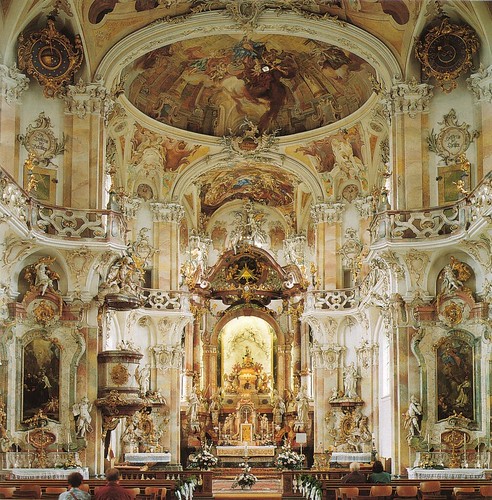
From: Hermann Brommer: The Birnau - shrine on Lake Constance . Published by Editions du Signe, BP 94, F-67 038 Strasbourg Cedex 2, ISBN 2-87718-756-X.
